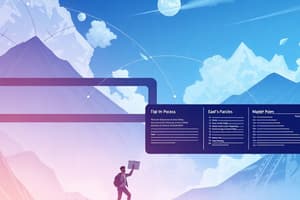Podcast
Questions and Answers
What is the primary role of records and information management professionals?
What is the primary role of records and information management professionals?
- To design and implement emerging technologies
- To control and safeguard the information assets of an organization (correct)
- To create records and information for organizational programs
- To destroy records and information at the end of their life cycle
What is a characteristic of records?
What is a characteristic of records?
- They are never preserved permanently
- They are only used for audit purposes
- They are evidence of actions and transactions (correct)
- They are only temporary
What is an example of an input device?
What is an example of an input device?
- A computer monitor
- A Logitech trackball mouse (correct)
- A computer processor
- A storage hard drive
What is input in the context of computing?
What is input in the context of computing?
Why are records and information management professionals responsible for addressing issues such as security, privacy, and disaster recovery?
Why are records and information management professionals responsible for addressing issues such as security, privacy, and disaster recovery?
What is a primary purpose of recording data?
What is a primary purpose of recording data?
Which of the following best defines a record?
Which of the following best defines a record?
In the context of records management, what does the life-cycle of a record refer to?
In the context of records management, what does the life-cycle of a record refer to?
Which of the following is NOT typically included in the definition of records?
Which of the following is NOT typically included in the definition of records?
What primarily distinguishes records from documents?
What primarily distinguishes records from documents?
Flashcards are hidden until you start studying
Study Notes
Recording Data
- Recording data involves documenting data and observations in various forms to preserve it for later use.
- It promotes the development of written, oral, visual, and digital literacy skills involved in documenting and organizing information.
- Skills involved in recording data include sketching, labeling, note-taking, journaling, photographing, and videotaping.
Records
- A record is a document that provides objective evidence of activities performed, events occurred, results achieved, or statements made.
- Records are created or received by an organization in the routine transaction of its business or in pursuance of its legal obligations.
- Records can consist of two or more documents and include accounts, agreements, books, drawings, letters, magnetic/optical disks, memos, micrographics, etc.
- Records function as evidence of activities, whereas documents function as evidence of intentions.
Records Management
- The records life-cycle consists of discrete phases covering the life span of a record from its creation to its final disposition.
- Records growth is expounded by modern electronic systems, resulting in rapid creation and capture of records by an organization.
- Examples of records phases include creation, modification, movement, and destruction of a record.
- Records and information management professionals are responsible for controlling and safeguarding information assets throughout the records life cycle.
Characteristics of Records
- Records are evidence of actions and transactions.
- Records should support accountability, allowing accountability to be traced.
- Records are related to processes, i.e. "information that is generated by and linked to work processes".
- Records must be preserved, some for a very short time and some permanently.
Input Devices
- An input device is any hardware device that sends data to a computer, allowing users to interact with and control it.
- Primary input devices on a computer are the keyboard and mouse.
- Other devices that can input data into a computer include trackballs, scanners, and microphones.
Studying That Suits You
Use AI to generate personalized quizzes and flashcards to suit your learning preferences.




